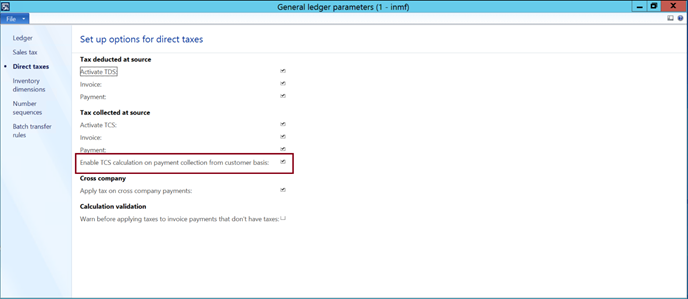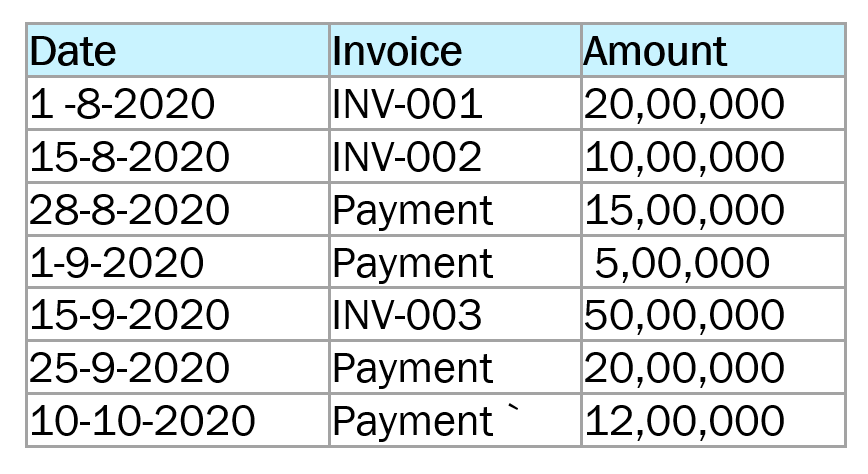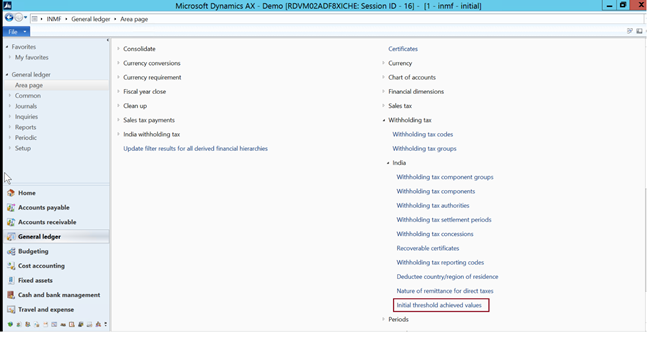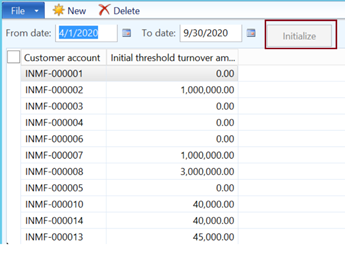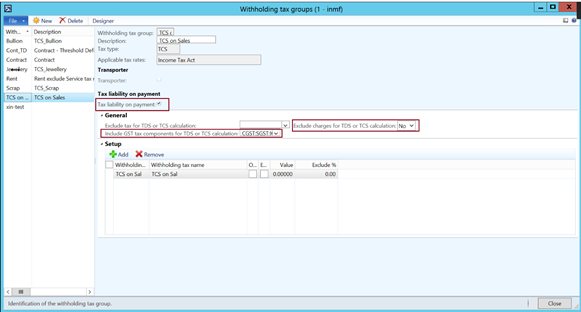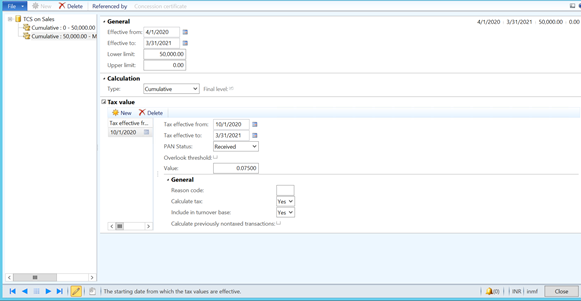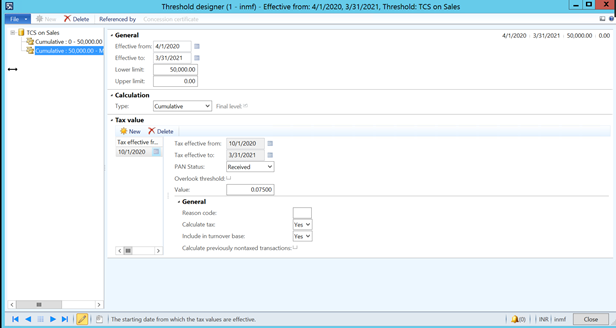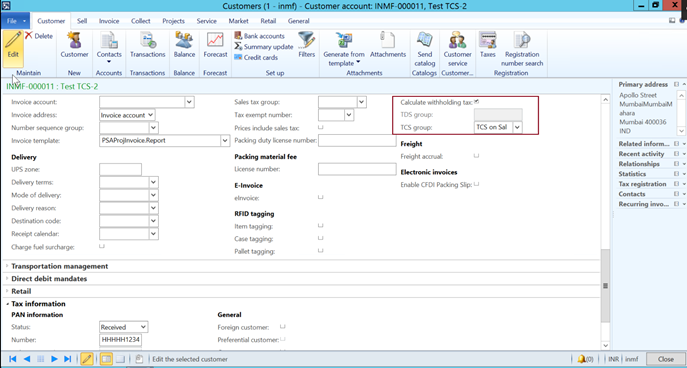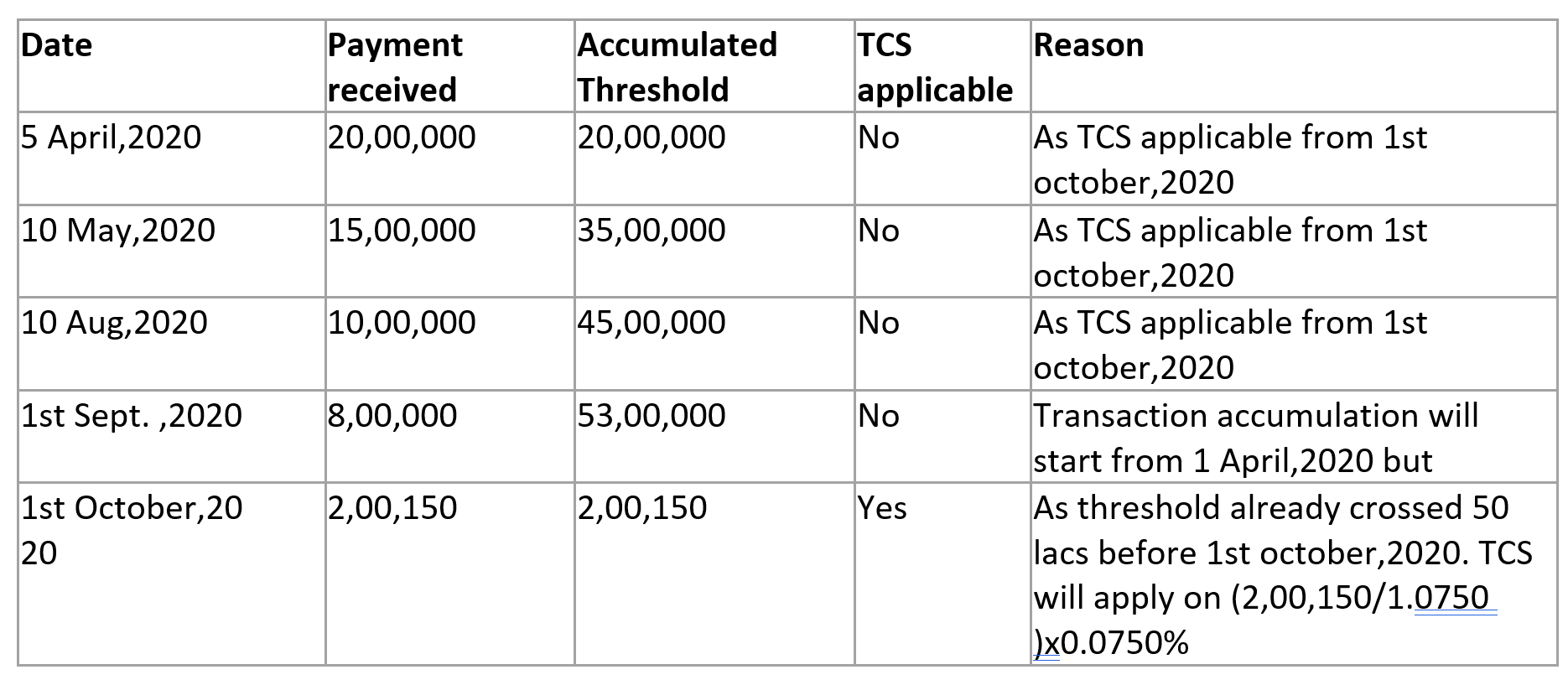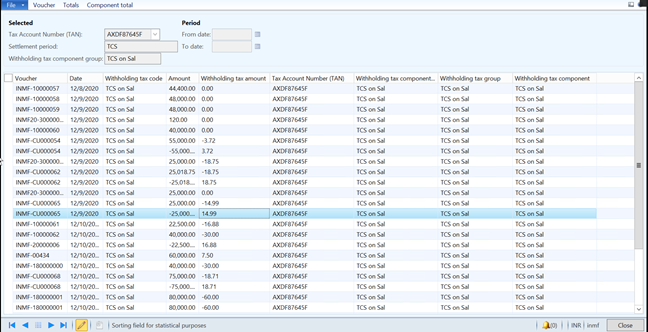Summary
TCS on sale of goods
This document covers the functionality of the Tax collection at Source (TCS) on the sale of goods. This feature describes how to do the basic setup for TCS deduction on sale of goods transaction, calculate TCS on transactions from a customer or on a group of customer, TCS on the transaction when a customer does not have PAN number, etc.
As per section 206C (1H) TCS should be collected at the time of receipt of payment from a customer against sales consideration. When the seller receives the payment TCS amount will be debited to the interim account and credited to the TCS payable account. On posting invoice, TCS amount will be posted to Interim payable account and added to invoice value
Another important aspect of this feature is that if multiple customers have the same PAN number then the accumulated transaction amount will be taken to compare with the threshold limit to determine the eligibility of transaction for TCS deduction.
The base amount for TCS deduction:
The CBDT vide circular no. 17 Dated 30.09.2020, has clarified that since the collection is made regarding receipt of the amount of sale consideration, no adjustment on account of indirect taxes including GST is required to be made for the collection of tax under this provision. Thus, TCS is required to be collected on the sale consideration inclusive of GST.
Under withholding tax group user has an option to include the GST Tax component and Charges to include in base amount for TCS calculation.
There was a lot of confusion about the implementation of this feature, To remove doubts arising on the applicability of new TCS provisions, the CBDT issued Circular No. 17, dated 30-09-2020 clarified that option ( c ) is more convenient, realistic, and reasonable to get the expected result.
PAN-based accumulation of transaction of multiple customers:
In the case of TCS on “sale of goods” deduction of TCS will be made based on PAN number. If multiple customers have the same PAN number then all transactions executed by different customers who have the same PAN will be accumulated and compared against the threshold limit prescribed by the government.
User has the option to accumulate purchase threshold based on PAN number of vendors like customers. However, accumulation will take place based on vendor or customer within one legal entity. Inter legal entity accumulation will be out of scope.
The point of collection of tax
As per the interpretation of TCS on sales of goods u/s 206C (1H), the tax should be collected at the time of receipt’. It is clarified under the law that TCS on sales of goods will be collected when actual payment is received by the seller.
However to collect TCS on the sale of goods, the seller needs to raise the sale invoice including the amount of TCS, account in the books as a TCS liability even in actual sense it is not payable. Even though the TCS amount is debited to the buyer, the liability under Section 206C (1H) does not arise until the time the amount is collected. To cater to this requirement new option “Tax liability on payment” is added under “Withholding tax group”.
On marking this option system will activate the “interim account” field under the withholding tax code. At the time of posting of sale of goods invoice Tax amount will be posted to “Interim TCS payable account” and debit to “customer account”. When the user receives payment from the buyer at that time system posted an invoice transaction to accrue TCS liability on payment.
TCS on Advance receipt of payment:
Every time the seller receives payment against sale consideration or receive an advance payment, the seller is mandated to deduct TCS under Section 206C(1H). The difficulty arises in the calculation of the amount when the payment received amount crosses the threshold value system to gross-up of transaction value and compute TCS amount where some manual adjustment of computed TCS amount is required. Initial two-quarters of user have to manually adjust the TCS amount computed on customer payment transactions
Changes Incorporated based on CBDT Press Release :
Initially for the new TCS provision following interpretations were made by the experts :
(a) Tax to be collected when both the amount of sale and the amount received as sale consideration exceeds Rs. 50 lakhs during the previous year;
(b) Tax to be collected when the amount of sale exceeds Rs. 50 lakhs irrespective of the amount of sale consideration received during the previous year;
(c) Tax to be collected when the amount received as sale consideration exceeds Rs. 50 lakhs irrespective of the amount of sale made during the previous year.
Based on the initial interpretation solution in Dynamics AX2012R3 was provided on option (a).
There was a lot of confusion about the implementation of this feature, To remove doubts arising on the applicability of new TCS provisions, the CBDT issued Circular No. 17, dated 30-09-2020 clarified that option ( c ) is more convenient, realistic, and reasonable to get the expected result.
To make the solution compliant with the new interpretation following changes have been incorporated into the existing feature :
-
Introduced “Initial achieved threshold value” concept: As per CBDT clarification, “it may be noted that this TCS shall be applicable only on the amount received on or after 1st October 2020. However the threshold is based on the yearly receipt, it may be noted that only for calculation of this threshold of Rs. 50 lakh, the receipt from the beginning of the financial year i.e. from 1st April 2020 shall be taken into account. For example, a seller who has received Rs. 1 crore before 1st October 2020 from a particular buyer and receives Rs. 5 lakh after 1st October 2020 would be required to collect tax on Rs. 5 lakh only and not on Rs. 55 lakh [i.e Rs.1.05 crore - Rs. 50 lakh (threshold)] but for threshold calculation amount received before 1st October will also be considered. To meet this change we introduced an initial threshold value concept.
-
TCS on the collection of payment from the customer against sales consideration:
As per CBDT clarification “It may be noted that this TCS applies only in cases where the receipt of sale consideration exceeds Rs. 50 lakh in a financial year. For example, a seller who has made sales of Rs. 1 crore before 1st October 2020 from a particular buyer and receives only Rs. 10 lakh after 1st October 2020 would not be required to collect tax on 10 lakh as the payment amount has not crossed the threshold value of Rs. 50.
Based on the above we provide an option under General ledger parameters to enable TCS deduction on the collection of payment from a customer against sales consideration.
-
Direct voucher posting of TCS amount on Payment and Invoice transaction: In the initial solution provided for TCS deduction, the posting was made through related vouchers. Redesign based CBDT press note enables the user to post TCS amount directly in the ledger without posting through a related voucher.
-
“TCS on sales” when applied on AP Transaction post-tax amount in recoverable account: In case the user applies “TCS on Sales” on the purchase transaction TCS amount will directly post to “TCS recoverable account”. User-has to do matching of TCS ledger with Form 26AS matching to determine the TCS amount for a claim against Tax liability.
-
The credit note will reverse the TCS transaction without impacting the accumulated value for the threshold: As the tax has to be computed on the consideration received from the buyer, the adjustment made to the ledger of the buyer by issuing the credit note will not have an impact on the tax to be collected. The posting would remain the same if, after the collection of tax, the seller repays some consideration to the buyer. In such a situation, the amount of sale consideration so received by the seller shall not be reduced with the amount so refunded for calculation of TCS.
-
User can enable defaulting of TCS group from Invoice account: Under feature management option is provided to the user to enable defaulting of TCS group on sales transaction from the Invoice account instead of the customer account. This allows the user to take care of third party invoice scenario.
-
User can enable defaulting of TCS group from vendor account in purchase transaction: Under feature management option is provided to the user to enable defaulting of the TCS group on purchase transaction if “TCS withholding group” is attached to the vendor account.
Out of scope scenarios:
-
Inter-company transactions will be out of scope for this feature.
The feature is supported in the following or later versions of Finance:
-
Dynamics AX2012R3
Steps to do the setup for TCS on sale of goods (On a collection of payment basis) :
There is three mandatory setup user have to do to enable “TCS on sales of good” on payment collection basis :
a. Enable feature through feature management :
Section 206C(1H) provides that tax is required to be collected where the amount is received as consideration for the sale of goods. In simple words, the tax should be collected where the amount is received on or after 01-10-2020. Thus, the trigger event is the receipt of sales consideration. To enable the feature on a collection of payment users have enabled this feature under “General ledger parameter”.
Path : General Ledger > Setup > General ledger parameters > Direct Taxes
b. Mandatory mark “Enable threshold hierarchy” option in the tax code “TCS on sales” for this feature :
it would be necessary to mark “Enable threshold hierarchy” in the tax code “TCS on sales of goods” to apply TCS rate based with and without PAN condition.
c. Mark “Liability on payment” check box under-withholding tax group “TCS on sales” It would be essential to mark the check box “Liability on payment” to deduct TCS at the time of collection
of payment.
Note :
-
In case the user does not mark “liability on the payment” the system will create TCS liability on the Invoice.
-
In case the user does not enable the feature under General ledger parameters “Enable TCS calculation on payment collection from customer basis” the system will consider both invoice and payment amount for threshold determination. (As working currently after the first release of the feature on TCS on sales )
Initialized “Initial threshold achieved value “ :
TCS will be applicable from 1st October but for threshold determination transaction accumulation will take place from 1st April of every financial year.
Example of how accumulated the value will be determined for TCS calculation :
Suppose threshold value INR .50,00,000
TCS applicable from 1st October 2020
Following transaction executed as below:
For customer Initial accumulated value will be determined as below:
Payment received from 1st April to 30th September 2020 (15,00,000+5,00,000+20,00,000) =40,00,000
Initial accumulated value = 40,00,000
First payment value after 10st October,2020 =12,00,000
Total accumulated value would be = 40,00,000+12,00,000= 52,00,000
TCS will compute as below:
52,00,000-50,00,000=2,00,000 *0.1% = 20
To compute the initial accumulated value following the new setup has been introduced :
Path : Tax >Setup>Withholding Tax > Initial threshold achieved value
Option Initial threshold achieved value:
Open the form and define the date range 1st April 2020 to 30th September 2020 and click on the “Initialized button”. The payment transaction executed in the given date range will be considered automatically to determine the initial threshold achieved value for each customer. Once the “initialize” the process is executed, the Initialize button will be disabled and can not be enabled again.
Users can edit the system-generated initial threshold value for any customer and on saving it will be recorded for the customer. Users can also add new customers manually, in case the new customer is created in the system after the initialization process. However initial threshold value needs to update manually.
Create new withholding tax code “Sale of goods”:
Path : Tax>Setup>withholding tax code >Sale of goods
When the user attaches the “withholding tax component” of type “TCS” the new field “Interim account” will enable.
Do not select any account until mark check box “Tax liability on payment” under “Withholding tax group.
Select “Enable threshold hierarchy”- “Yes”.
On selection of “Yes” “PAN-based accumulation “option will enable
User can mark this option if dealing with customers have the same PAN number.
Create a new withholding tax group “Sale of goods.”
Path : Tax>setup>withholding tax group>Sale of goods
Create a withholding tax group with tax type “TCS” and mark check box “Tax liability on payment”-Yes.
After this go back to the withholding tax code form and select “ “Interim TCS payable account” in the field “Interim account” created in the chart of account with posting type “India withholding tax (TCS)
Include GST tax component if part of TCS base amount calculation under the field “Include GST tax component for TDS or TCS calculation “
If charges are not part of TCS calculation selection “Yes” under the field “Exclude charges for TDS or TCS calculation”
Click on the “Designer” button on the action pane and define the TCS calculation formula.
Define Threshold definitions:
Path : Tax > Setup > Threshold definitions.
Define threshold definition for “Sale of goods.”
Two threshold slabs have to be defined.
-
0-Max
-
Max-0
TCS Threshold setup for “Sale of goods”
TCS on sales of goods applies to a single customer or multiple customers having the same PAN number.
If the customer PAN number is not available higher tax rate will apply after crossing the exempted turnover amount.
If a customer has a PAN number then a lower tax rate will apply.
Users need to define threshold reference for customers:
Click on Threshold designer
Define two slabs with option:
-
With PAN number
-
Without PAN number
Define a separate TCS rate for each option.
When defining the calculation basis for exempted slab
-
Calculate tax – No
(Another option Calculate tax – Yes and value – 0)
-
Calculate previous non-tax transactions-No.
-
Include in turnover base – Yes.
When defining the calculation basis for Taxable slab
-
Calculate tax – Yes.
-
Calculate previous non-tax transactions-No.
-
Include in turnover base – Yes.
It is very important to note that in the “Threshold designer” user has to define the date for each slab from 4/1/2020 – 3/31/2021. The system checks if the threshold date range includes the initial amount date range. If it does, the system adopts the defined initial amount as a part of turnover and does not consider the transactions during the initial amount date range, for the turnover during the date range has been defined as the initial amount. In the above case, the threshold date range ‘4/1/2020 – 3/31/2021’ includes the date range ‘4/1/2020 – 9/30/2020’, so it takes the initial threshold amount as part of the turnover, and then cumulates the payments of date range ‘10/1/2020 – 3/31/2021’ as another part of turnover. Finally, the total turnover is the initial threshold amount + cumulative amount of ‘10/1/2020 – 3/31/2021’.
Activate calculation of TCS for the customer:
Accounts Receivable>Customers > All customers
Posting of Invoice and payment transactions and computation of TCS.
-
Threshold limit : 50,00,000
-
TCS rate : 0.0750
-
Below is transaction details :
The tax rate in three decimal placesKey scenarios covered :
-
Sales Order
-
Free Text Invoice
-
Customer payment Journal
-
Project Invoice
-
General Journal
-
Multi-line Journals
-
TCS through Invoice account
-
PAN-based accumulation of threshold
-
Credit note
When the user initializes “Initial Threshold achieved value” the system will compute and display INR 53,00,000.
On posting payment of 2,00,150received from the customer following accounting entry will be posted :
Accounting entries:
Note : The user has to manually adjust the TCS computed amount when the system first time crosses the threshold amount. The difference will be minor. The variation in the calculation is due to the current algorithms works differently. It will be corrected in the next release.
When an invoice is posted, against last payment transaction entry will be posted as below
TCS on Purchase of goods deducted by vendor:
In case TCS is deducted against the organization by the selling vendor, the user can apply the same withholding tax group “TCS on sales of goods”. The threshold will not apply to the purchase transaction. On posting purchase, order TCS amount deducted by vendor posted to TCS recoverable account directly. Users have to download Form 26AS from govt. website to match the recoverable amount before claiming the government.
Every Organization will claim credit for TCS deduction after reconciling the deduction with Form 26AS.
Go to Tax>>Inquiries > Tax >Withholding Tax > TCS
Users can select required column fields to generate the report.
Symptoms
When cash payment collected from customer exceed INR 50 Lakhs during the financial year.
Resolution
Apply TCS rate on amount exceed accumulated payment value exceeds 50 lakh.
Hotfix information
User has to Install original TCS on sales feature through KB 4089749 and KB4528707. After this, need to install the current fix through KB 4598394.The installation order is the same as ascending number order, i.e. KB4089749 -> KB4528707 -> KB4598394.
https://fix.lcs.dynamics.com/issue/results/?q=4598394
More information
You can contact technical support for Microsoft Dynamics by phone using these links for country-specific phone numbers. To do this, visit one of the following Microsoft websites:
Partners
https://mbs.microsoft.com/partnersource/resources/support/supportinformation/Global+Support+Contacts
Customers
https://mbs.microsoft.com/customersource/northamerica/help/help/contactus
In special cases, charges that are ordinarily incurred for support calls may be canceled if a Technical Support Professional for Microsoft Dynamics and related products determines that a specific update will resolve your problem. The usual support costs will apply to any additional support questions and issues that do not qualify for the specific update in question.
Note This is a "FAST PUBLISH" article created directly from within the Microsoft support organization. The information contained herein is provided as-is in response to emerging issues. As a result of the speed in making it available, the materials may include typographical errors and may be revised at any time without notice. See Terms of Usefor other considerations.


